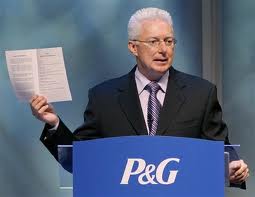Seven Strategies (But Not For Success)
 What strategies don’t work? I had been trying to organize bad strategies into a mental map when I came across an article in The Economist that did the heavy lifting for me. In its own pithy way, The Economist names and shames six strategies that just don’t work. To that, I’ll add a seventh.
What strategies don’t work? I had been trying to organize bad strategies into a mental map when I came across an article in The Economist that did the heavy lifting for me. In its own pithy way, The Economist names and shames six strategies that just don’t work. To that, I’ll add a seventh.
Here are The Economist’s six along with my own pithy observations.
The Do-It-All strategy — don’t make the hard product choices. When you find market opportunities, pursue all of them. If you build enough products, something is bound to sell. This is sometimes known as the Food-Fight strategy — throw a bunch of food at the wall and see what sticks.
The Don Quixote strategy — launch a frontal attack on your strongest competitor. Take the fight right to them. It sounds bold — and everybody wants to be bold these days — but it’s well nigh suicidal. Its main advantage compared with the Do-It-All strategy: it’s over quickly. As Sergeant York taught us, don’t fire at the lead goose in the flying wedge. Fire at the last one and work your way forward.
The Waterloo strategy — fight on too many fronts at once. Rather than carving up the battlefield to your advantage, attack multiple enemies at once. That’ll teach ’em. Just like at Waterloo.
The Something-for-Everyone strategy — what’s our target market? Anyone who has money. This is often found in combination with the Do-It-All strategy. We’ve got lots of products, so let’s find lots of customers. One of the strengths of Lawson Software’s strategy is that we were very clear about who we served and who we didn’t. We turned down prospective customers who didn’t fit our profile. We couldn’t serve them successfully without distracting attention from our priority customers.
The Programme-of-the-Month strategy — first it was Pursuit of Excellence, then it was Built to Last, then it was … well, whatever the latest hot business book is. We’re dedicated to pursuing the fashionable strategy of the moment. Better to pick a simple strategy and stick with it.
The Dreams-That-Never-Come-True strategy — ambitious mission statements are never translated into clear choices. At some point, you have to come down out of the clouds and pursue this market (as opposed to that one) with this plan (as opposed to that one). It’s about making choices.
To The Economist Six, I’ll add a seventh:
The Military/Territorial strategy — the market is like a piece of territory that multiple armies are fighting over. There’s only so much territory; it can’t be expanded. If a competing army wins more of it, we will win less of it. It’s a zero sum. We have to stay focused on the competition and counter every maneuver. It’s a popular analogy but a bad one. War is about defeating the enemy. Business is about winning the customer. Focusing on the competition won’t get you there.
As I’ve written before, strategy is about what you don’t do. It’s about making hard choices that allow you to focus on markets or products or customers where you have the greatest chance of success. Forget everything else.
Strategy: Five Components
A.G Lafley is justifiably famous for taking over Procter & Gamble (P&G) and converting an insular company into a customer-centric, outward-looking culture known for a string of successful innovations. When Lafley became CEO in 2000, innovation was driven by thousands of in-house R&D designers, researchers, and engineers. They created neat stuff and “pushed” it to customers. Partially as a result, P&G’s success rate with new products and brands hovered around 15%. The R&D teams focused internally; only about 10% of new products came from outside the company.
Lafley essentially turned the company inside-out by putting the customer at the head of the innovation process. P&G called it Connect + Develop and emphasized collaboration with other departments, customers, and even outside research organizations. Lafley changed the culture from “not invented here” to “proudly found elsewhere”. P&G signed more than 1,000 collaborative agreements with outside organizations. It was a fundamental cultural change and the results were spectacular. According to a report from A.T. Kearney, “During Lafley’s tenure, sales doubled, profits quadrupled, and the company’s market value increased by more than $100 billion”.
Now Lafley has written a book, Playing to Win: How Strategy Really Works, with Roger Martin, the Dean of the Rotman School of Management at the Univeristy of Toronto. Martin was Lafley’s “principal external strategy advisor”. In addition to Martin, Lafley built a brain trust of outside thinkers including designers and business professors. The eclectic nature of the group created many different “idea collisions” that generated process innovations as well as product innovations.
I’m sure that I’ll write a lot about the book in the future but it’s not quite out yet. It debuts in February. Today, I’m depending on the report from A.T. Kearney and a lengthy review from The Economist. One of the key insights is that P&G followed a strategy composed of five elements, each designed to help managers make the right decisions. These are:
- What does winning look like? What are we aiming for and what information do we look for along the way to help us understand if we’re making progress? Do we seek global domination, regional, or local?
- Which markets should we play in? Of course, this also implies another question: which markets should we ignore (or exit)? How do we determine which is which?
- How do we win? What’s our distinctive strategy in each market and category?
- What are our strengths and weaknesses and how do we deploy them in each market, against each competitor?
- What needs to be managed for the strategy to succeed? Of course, the inverse of this question is what doesn’t need to be managed? The Economist reports that one of Lafley’s “most important innovations was a slimmed-down strategy-review process … [that] replaced needlessly sprawling bureaucratic meetings….”
It’s a good story and an intriguing look at strategy. Unfortunately, it doesn’t have an entirely happy ending. The Economist reports that P&G has “stumbled badly” since Lafley left in 2009. Similarly, Martin’s consulting firm “got into financial difficulty and has been sold at a discount.” Still, the questions are relevant to any company’s strategy and the story is intriguing. I’ll report more soon.
Strategy: What Wouldn’t You Do?
 In many ways, strategy is simple. Yet we often want to make it more difficult and more complicated than it really is. We want it to sound powerful and provocative. We want to inspire our employees and investors with eloquent phrases and motivational messages. But strategy, in itself, is not inspirational. You can create inspirational messages about your strategy but the strategy itself simply says, “we do this; we don’t do that”.
In many ways, strategy is simple. Yet we often want to make it more difficult and more complicated than it really is. We want it to sound powerful and provocative. We want to inspire our employees and investors with eloquent phrases and motivational messages. But strategy, in itself, is not inspirational. You can create inspirational messages about your strategy but the strategy itself simply says, “we do this; we don’t do that”.
Be sure to separate the messaging (and the inspiring) from the strategy per se. A simple way to clarify your strategy is to focus on what you don’t do. By clearly defining what you don’t do, you can save yourself a lot of time and grief. You can invest that time into doing a better job of what you do do. That’s inspirational.
Learn more in the video.
